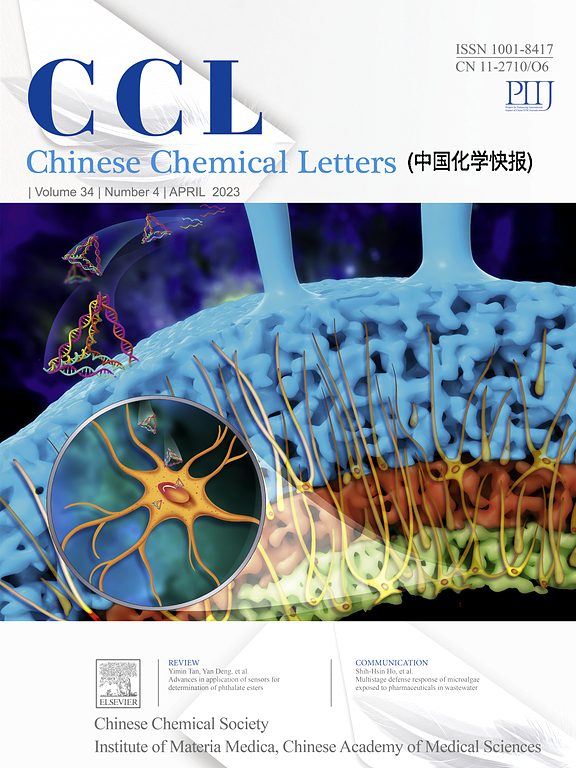Pyridine-based ionic sp2 carbon-conjugated covalent organic frameworks for selective extraction of Pu(IV) from high-level liquid waste
IF 9.4
1区 化学
Q1 CHEMISTRY, MULTIDISCIPLINARY
引用次数: 0
Abstract
In the current era marked by energy shortages, the advancement of nuclear energy stands as an inevitable progression. The reprocessing of spent nuclear fuel plays a crucial role in determining the sustainability of nuclear energy as a viable energy source. Among these processes, the separation and recovery of Pu(IV) from high-level liquid waste (HLLW) hold paramount significance in terms of safety and strategic implications. Herein, this work focused on the synthesis of two acid- and radiation-resistant pyridine-based sp2c-COFs (COF-IHEP3 and COF-IHEP4), followed by the creation of two pyridine-based ionized sp2c-COFs named COF-IHEP3-CH3NO3 and COF-IHEP4-CH3NO3 through post-modification. These materials have potential anion exchange capacity for the selective separation of Pu(IV) in highly acidic conditions. Notably, in 8 mol/L nitric acid solution, COF-IHEP3-CH3NO3 demonstrated the capability to eliminate plutonium within 20 min in 98% removal efficiency with a Kd value of 2450 mL/g. Experimental and theoretical analysis suggest that the ionized sp2c-COFs exhibit exceptional stability, selectivity, and prevention of secondary contamination towards Pu(IV) in the presence of multiple ions environments. In short, this work provides an appropriate anion exchange strategy to design ionic sp2c-COFs as a promising platform for Pu(IV) recovery from HLLW.
吡啶离子sp2碳共轭共价有机框架选择性萃取高放废液中的Pu(IV)
在当今能源紧缺的时代,核能的发展是必然的。乏核燃料的后处理在决定核能作为一种可行能源的可持续性方面起着至关重要的作用。在这些过程中,从高放废液(HLLW)中分离和回收Pu(IV)在安全性和战略意义方面具有至关重要的意义。本文首先合成了两种抗酸和抗辐射的吡啶基sp2c-COFs (COF-IHEP3和COF-IHEP4),然后通过后修饰制备了两种吡啶基电离的sp2c-COFs,分别命名为COF-IHEP3- ch3no3和COF-IHEP4- ch3no3。这些材料具有潜在的阴离子交换能力,可在强酸性条件下选择性分离Pu(IV)。值得注意的是,在8 mol/L的硝酸溶液中,COF-IHEP3-CH3NO3表现出在20 min内去除钚的能力,去除率为98%,Kd值为2450 mL/g。实验和理论分析表明,电离后的sp2c-COFs在多离子环境下表现出优异的稳定性、选择性和防止Pu(IV)二次污染的能力。总之,这项工作提供了一种合适的阴离子交换策略,以设计离子sp2c-COFs作为从HLLW中回收Pu(IV)的有前途的平台。
本文章由计算机程序翻译,如有差异,请以英文原文为准。
求助全文
约1分钟内获得全文
求助全文
来源期刊

Chinese Chemical Letters
化学-化学综合
CiteScore
14.10
自引率
15.40%
发文量
8969
审稿时长
1.6 months
期刊介绍:
Chinese Chemical Letters (CCL) (ISSN 1001-8417) was founded in July 1990. The journal publishes preliminary accounts in the whole field of chemistry, including inorganic chemistry, organic chemistry, analytical chemistry, physical chemistry, polymer chemistry, applied chemistry, etc.Chinese Chemical Letters does not accept articles previously published or scheduled to be published. To verify originality, your article may be checked by the originality detection service CrossCheck.
 求助内容:
求助内容: 应助结果提醒方式:
应助结果提醒方式:


